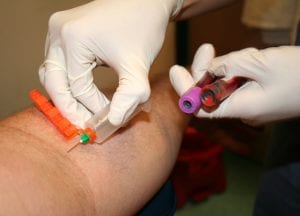Everyone at one time or another has had to have their blood drawn. For the most part it is not the most pleasant experience. Some people say that it doesn’t hurt while others say that they
feel the, “pinch”. Have you ever wondered why? Well, maybe it would make sense that it does hurt, when you think about a needle going through the multiple layers of epidermis into the vein.
But for others they may not feel any pain. The interesting thing is that we feel pain in various ways, all relating to the nerve endings located at varying depths throughout our skin. The term nociceptor is another work for pain receptors. These are important to have, for the shear fact that if we didn’t have them, we suffer serious injury and not even know it. Nociceptors are actually found not only in our epidermis but also in muscle, joints, bone and viscera. Most of the action potential, or the mitigating migratory pathway of pain goes to our brain from bare nerve endings. The pathway that these nerve endings follow is through the dorsal root and trigeminal ganglia. Did you know that there is no nociceptor found inside the central nervous system? Looking at these nociceptors, it is interesting that they can exhibit different types of pain recognition, such as responding to mechanical (pressure or touch), thermal (heat or cold) and chemical (damage/inflammation).
Within the skin, nociceptors are divided into categories based upon function. The high threshold mechanonociceptors respond to intense mechanical stimulation, such as pressing, stretching or cutting. The sting of the venipuncture needle fits into this category. Within the epidermis are four major types of mechanoreceptors. These include, Merkel’s disks, Meissner’s corpuscles, Ruffini ending and Pacinian corpuscles. Merkel’s disk are slow adapting, unencapsulated nerve endings that respond to light touch. These can be found in the upper epidermis where there are hair follicles.
Meissner’s corpuscles are rapid acting and are encapsulated neurons and respond to fine touch. Ruffini ending are slow acting and respond to skin stretch. The Pacinian corpuscles are rapid twitch deep receptors that respond to deep pressure.
Now if we look at the steps when the needle punctures the skin, if the phlebotomist applies pressure with their finger prior to the insertion of the needle the brain will pick up the sensation of deep pressure and the Pacinian corpuscles will signal the brain. Simultaneously, when the needle is inserted into the epidermis, the brain will receive the sensation from Meissner’s corpuscles. While the brain is focusing on the pressure that is being applied to the arm, the pain felt by the needle insertion will lag behind slightly because the brain is focusing on the sensation of pressure. By the time the needle is actually in the vein there will be sensation of pain or very minimal sensation of pain.
Therefore, it is important that the phlebotomist is trained in understanding the concept of nociceptors. At Phlebotomy Career Training we train phlebotomist in all these concepts and more. If becoming a phlebotomist who knows how to keep the patient free from pain, come and learn at our school.

Nancy L. Kimmel obtained her PhD in Environmental Engineering in 2002, then went on to teach Physics and Mechanical Engineering at Lawrence Technological University, Henry Ford College and Oakland University. She obtained her Associate in Nursing from Henry Ford College and then went on to earn her Master Degree as a Family Nurse Practitioner and became Board Certified working as a licensed FNP in the State of Michigan. She then went on to Medical School where she is now in her 3rd year, and is also in the process of obtaining her Doctorate in Nursing Practice through Chamberlin University. She has authored the NET Study Guide, as well a several books on subjects of Math, ECG/EKG and Phlebotomy. She holds a patent on an Air Filter through the U.S. Patent Office.


